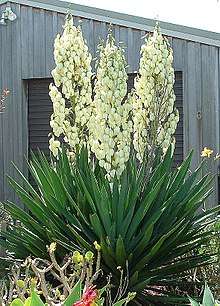Yucca filamentosa
Yucca filamentosa,[1] Adam’s needle and thread,[2] is a species of flowering plant in the family Asparagaceae[3] native to the southeastern United States. Growing to 3 m (9.8 ft) tall, it is an evergreen shrub valued in horticulture for its architectural qualities.
| Yucca filamentosa | |
|---|---|
 | |
| Scientific classification | |
| Kingdom: | Plantae |
| Clade: | Tracheophytes |
| Clade: | Angiosperms |
| Clade: | Monocots |
| Order: | Asparagales |
| Family: | Asparagaceae |
| Subfamily: | Agavoideae |
| Genus: | Yucca |
| Species: | Y. filamentosa |
| Binomial name | |
| Yucca filamentosa | |
Y. filamentosa is closely related to Yucca flaccida and it is possible they should be classified as a single species.[4]
Names
Its common names include Adam's needle, common yucca, Spanish bayonet,[5] bear-grass, needle-palm, silk-grass, and spoon-leaf yucca.[6]
Description
.jpg)
Usually trunkless, it is multisuckering with heads of 75 cm (30 in) long, filamentous, blue-green, strappy leaves. Y. filamentosa is readily distinguished from other yucca species by white, thready filaments along the leaf margins.[7] Flower stems up to 3 m (10 ft) tall bear masses of pendulous cream flowers in early summer.[4] They are pollinated by the yucca moth Tegeticula yuccasella.[8][9] Other moth species, such as Tegeticula intermedia, also use this yucca as a host plant to lay their eggs.[10]
Distribution and habitat
Yucca filamentosa is found from southeast Virginia south to Florida, and as far west as south and southeast Texas.[4] It has become naturalized along the Atlantic coastal plain north to Long Island Sound and into areas of the lower Midwest. It is reportedly also naturalized in France, Italy and Turkey.[11]
This plant is most commonly found in sandy soils, especially in beach scrub and dunes, but also in fields, barrens, and rocky slopes, though it grows well also in silt or clay soils.
Cultivation
Y. filamentosa is widely cultivated in mild temperate and subtropical climates. A fairly compact species, it nevertheless presents a striking appearance with its sword-like leaves and dramatic flowerheads. It is naturally a focal point in the landscape, also providing a tropical touch in temperate gardens. It needs full sun and a well-drained soil, preferring an acid or slightly alkaline pH range of 5.5 to 7.5. It develops a large, fleshy, white taproot with deep lateral roots. Once planted and established, it is difficult to remove, as the roots keep sending up new shoots for many years. It is normally hardy down to −15 °C (5 °F) (USDA hardiness zones of 5 to 9: UK H5).
Cultivars
'Bright Edge', a dwarf cultivar with yellow-margined foliage and creamy flowers tinged with green, has gained the Royal Horticultural Society's Award of Garden Merit.[12][13] ‘Color Guard’, with broad yellow stripes all year plus red stripes in the winter, has also won the award.[14]
Other cultivars include:
- 'Golden Sword' - similar to 'Bright Edge', but larger
- 'Ivory Tower' - creamy white flowers tinged with green
Uses
Once the seeds have been removed, the fruits can be cooked and eaten. The large flower petals can also be eaten in salads.[15]
The leaves, stems and roots of this plant can be used to stun fish.[16] The Cherokee used it for this purpose.[17]
References
- Linnaeus, Species Plantarum 1: 319. 1753.
- "Yucca filamentosa". RHS. Retrieved 11 March 2019.
- Yucca filamentosa. Integrated Taxonomic Information System (ITIS).
- "Yucca filamentosa". Flora of North America.
- Yucca filamentosa. NatureServe. 2012.
- "Yucca filamentosa". Germplasm Resources Information Network (GRIN). Agricultural Research Service (ARS), United States Department of Agriculture (USDA). Retrieved 4 January 2018.
- The Reader's Digest Gardeners' Encyclopedia of Plants and Flowers. Reader's Digest Association. Sydney. 1999.
- Marr, D. L., et al. (2000). Pollen dispersal in Yucca filamentosa (Agavaceae): the paradox of self-pollination behavior by Tegeticula yuccasella (Prodoxidae). American Journal of Botany 87(5), 670-77.
- Wunderlin, R. P. 1998. Guide to the Vascular Plants of Florida i–x, 1–806. University Press of Florida, Gainesville.
- "Tegeticula intermedia". tolweb.org. Retrieved 2017-11-16.
- Kew World Checklist of Selected Plant Families
- "RHS Plant Selector - Yucca filamentosa 'Bright Edge'". Retrieved 10 June 2013.
- "AGM Plants - Ornamental" (PDF). Royal Horticultural Society. July 2017. p. 107. Retrieved 18 February 2019.
- "Yucca filamentosa 'Color Guard'". RHS. Retrieved 11 March 2019.
- Niering, William A.; Olmstead, Nancy C. (1985) [1979]. The Audubon Society Field Guide to North American Wildflowers, Eastern Region. Knopf. p. 616. ISBN 0-394-50432-1.
- Duffy, K. (2004). Harvesting Nature's Bounty, Second Edition. City: Bookman Pub. ISBN 1-59453-294-X.
- Yucca filamentosa. Native American Ethnobotany. University of Michigan, Dearborn.
External links
| Wikimedia Commons has media related to Yucca filamentosa. |
